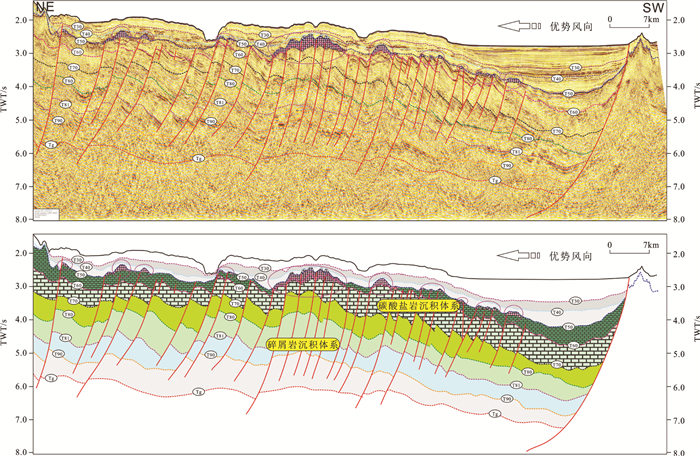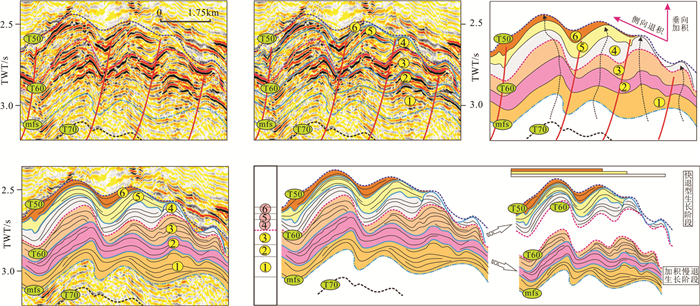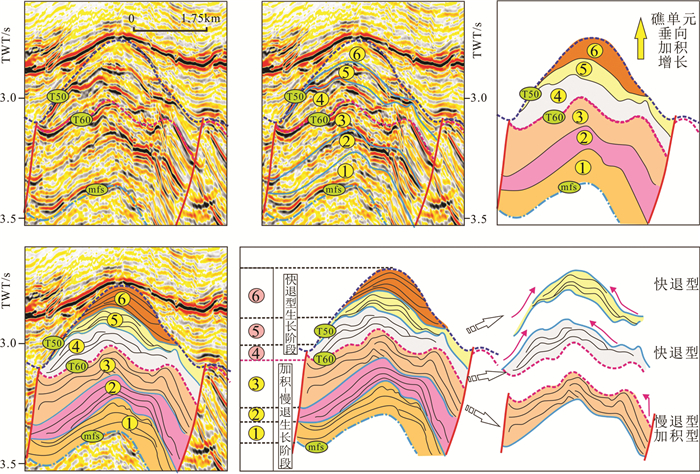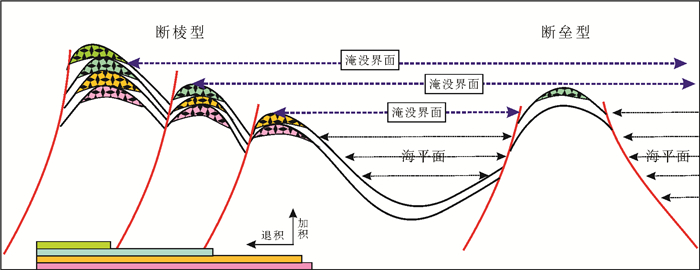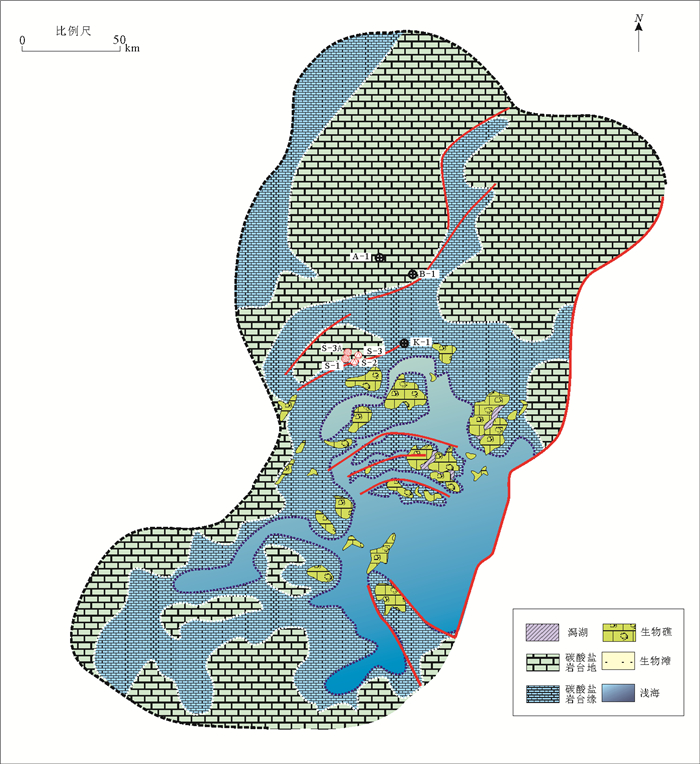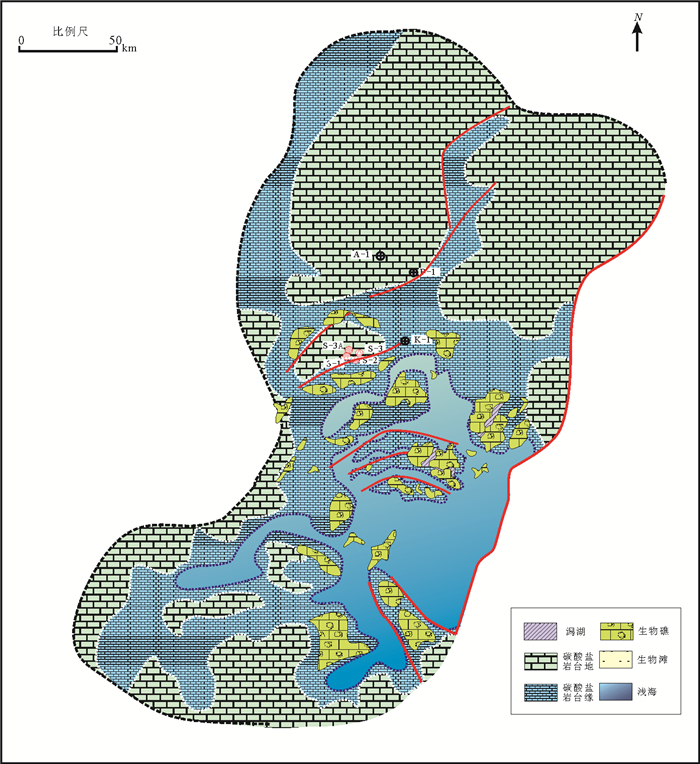A development model for Late Oligocene to Early Miocene reefs in the Liyue Basin of South China Sea
-
摘要: 生物礁具有良好的油气聚集能力,故一直是石油地质学家关注的焦点。礼乐盆地具有优良的成礁条件,但受限于资料品质,生物礁的研究仅仅处在起步阶段。本文借助重新处理的2D地震数据,利用地质-地球物理精细刻画技术,对礼乐盆地T70—T50时期生物礁进行了精细解剖。研究认为,T70—T60时期是礁体初始发育阶段,T60—T50时期是礁体主发育阶段。盆内可以识别出断棱型和断垒型两种礁体结构模型,其中断棱型又细分为多棱型和单棱型。断棱型是研究区的主要礁体构型。礁体的空间生长表现为侧向退积和垂向加积耦合过程。礁体结构可以细分为6期生长单元,前三期是加积慢退型生长,后三期为快退型生长。礁体的空间展布形态与生长速度受海平面升降、可容纳空间变化和古地貌形态联合控制。Abstract: As a good reservoir for hydrocarbon accumulation, reefs have become a major concern of petroleum geologists for many years.The Liyue Basin in South China Sea is an excellent place for reef development. However, since lack of data, especially high quality seismic data, the research of Liyue Basin still remains in an initial stage up to date. This time, based on the re-processed 2D seismic data, using the up to date geological-geophysical analysis techniques, we studied the reef deposits during the period of T70-T50 in the Liyue Basin. It is found that reefs started growing in the time of T70-T60 and entered a booming stage in the period of T60-T50. Both hummocky shaped and lenticular reefs are discovered.The hummocky shaped reefs, which dominate the research area, can be further divided into single and multiple according to the number of hummocky structures. The growth of hummocky reefs is a combination of lateral retrogression and vertical accretion. From the view point of internal structure, the reef can be subdivided into 6 growth units, the first 3 stages shows a slow retrogression and the last 3 stages are the stages of rapid growth. The growth rate of the reefs is jointly controlled by sea level fluctuation, accommodation space and paleogeography.
-
Keywords:
- distribution /
- development model /
- reefs /
- Liyue Basin /
- South China Sea
-
生物礁是碳酸盐储层中的核心部分,由于其储层具有良好的物性条件,故易形成大型油气藏[1-9]。南海是中国油气勘探的重点地区之一,也是生物礁广泛发育的区域。南海目前共发现油气田200多个,有为数不少的生物礁油气藏[10-16]。对于我国而言,针对南海生物礁的深度研究主要是围绕琼东南盆地、珠江口盆地展开,已经获得了生物礁储层的油气,如流花11(Chip,2000);而对于南海中南部的生物礁研究,还处在初级的调查阶段,已有的认识主要是基于对现代生物礁的考察、早期海调过程中获得的地震剖面,研究程度远远不能和南海北部礁区相比。实际上,根据周边国家的研究情况,南海中南部发育有大量的生物礁且是高质量的油气储层,如北巴拉望盆地、礼乐盆地、曾母盆地、西沙群岛、万安盆地等[17-25],但由于受资料匮乏的限制,我国目前对于南海中南部生物礁的研究处于刚刚起步阶段。
1. 区域地质概况
礼乐盆地是南海中南部最大的盆地,北邻中央海盆,东邻巴拉望盆地,南邻南沙海槽盆地,西邻南华北盆地和安渡北盆地,面积4.5×104km2,水深变化在0~2000m之间(李鹏春等,2011)。国外油公司的勘探实践已表明,礼乐盆地具有较好的油气资源前景。Fatima Alvarez Castillo(2012)初步估计礼乐盆地拥有4.4亿桶油当量资源,且92%为天然气。菲律宾是礼乐盆地及巴拉望盆地研究的主力。至2003年,菲律宾在西北巴拉望盆地共进行了85400km的二维地震和5300km2的三维地震,共钻井126口,发现一批中小型的油气田[10-16]。对于我国而言,由于资料的限制,对于礼乐盆地的研究非常薄弱,目前的研究认为,礼乐盆地沉积充填由两部分组成,古近系主要以碎屑岩沉积为主(T100—T70),南海运动之后,盆地的沉积以碳酸盐为主,尤其是23.8Ma (T70)—16Ma (T50)期间是生物礁主要发育时期(图 1),但是由于受到资料的限制,对于生物礁的结构、特征及其分布都不是很清楚[26-34]。在本次研究中,利用重新处理过的二维地震资料,对上渐新统至下中新统发育的生物礁进行了精细的解剖,细分了类型,划分了期次,建立了模型。
2. 生物礁生长结构与模式
借助重新处理过的2D地震数据,利用地质-地震综合分析手段,对研究区生物礁进行了精细分析。通过分析发现,生物礁主要发育在T60—T50时期,尤其是集中发育在T50界面之下。T70—T60时期主要以碳酸盐沉积为主,礼乐盆地整个被碳酸盐系统覆盖,在这个时期生物礁不发育。此外,还可以看到,生物礁一般发育在比较孤立的构造高地之上,在侧向上是一种串珠状展布的特征,并未连片成带。仔细研究后发现,生物礁这种特征是与下伏断层的控制密切相关的(图 2)。
受断层的影响,在研究区形成两种主要类型的高地:断棱型与断垒型。断棱型进一步可以识别出两种亚类:多棱型与单棱型。这几种类型均是受构造作用而形成的有利于生物礁发育的孤立高地,为生物礁的生长提供了基座。
2.1 断棱型结构
断棱型结构是受控于一对或者一组同向断层控制而形成的掀斜高地。生物礁就生长在这些高地之上。这类高地轮廓不对称,断层呈现的是隐伏状态,因此上部地层没有被切断,故而顶部发育的生物礁会连在一起。进一步的分析发现,断棱型结构包含了两种类型:多棱型与单棱型,它们对于礁体的生长具有不同的控制作用(图 3)。
2.1.1 多棱型台地结构与生物礁发育
多棱型台地是有多条同向断层掀斜而形成的一组棱形高地。很明显可以看到,生物礁主要发育在中上部,即上渐新统与下中新统时期。地震同相轴能量强,反射外形呈现不对称丘状。进一步仔细研究发现,实际上生物礁的生长可以细分出6期,其生长过程具有明显的垂向加积和侧向退积特征。在垂向上,生物礁依次往上叠加生长,但是这种叠加不是对称性的叠加,而是退积式的叠加,即晚期的礁体生长是在上期礁体的基础上逐渐向构造高点迁移,礁体发育中心的迁移曲线清楚地展示了这种过程(图 4)。
不过,这种退积式的迁移过程并不是一成不变的,而是表现出了阶段性。早期是一种加积慢退的生长过程。在这个过程中,礁体的生长在垂向上的加积占据主导地位,在侧向上是一种缓慢的节奏,因此表现出来以垂向生长为主的过程。在这个阶段主要是mfs-T60时期,即礁体发育的①、②、③期;晚期礁体往高地的迁移速度加快,退积占据了主导地位,加积过程弱化,因此这个阶段称为快退型生长阶段,主要以礁体发育的④、⑤、⑥期为主(图 4)。
2.1.2 单棱型台地结构与生物礁发育
单棱型台地是由2条同向断层掀斜而形成的单个高地。生物礁的丘状发射结构非常明显, 而且期次非常易于识别,共识别出6期礁体单元,礁体单元在垂向上呈现的是一种加积增生过程(图 5)。
进一步的研究表明,各礁体单元内部礁的生长方式是不尽相同的。①、②、③期礁体是慢退加积生长过程,而从第④期礁体开始,礁体内部开始呈现快速的退积增长趋势,晚期的礁单元快速地往高处退积,礁体的生长范围快速缩小,这个过程称为快退型生长阶段,一直持续到礁体发育结束(图 5)。
2.2 断垒型结构
断垒型结构是另外一类台地形态。它是由两条相对的正断层对掉之后形成的地垒型的高地。生物礁就发育在高地之上。与断棱型台地礁相比,此类台地礁厚度较薄,且发育较晚。通过对比发现,断垒型台地上的礁体相当于断棱型台地礁的⑤、⑥期,是一种快速的退积生长。由于每期礁单元较薄,因此内部结构较难划分(图 6)。
2.3 发育模式
在对礼乐盆地生物礁生长结构解剖的基础上,建立了该区生物礁发育模式(图 7)。图 7清楚地显示了两类生物礁发育构型。实际上,生物礁发育主要受控于构造(古地貌)与海平面。首先,研究区发育一系列正断层,同向正断层形成掀斜断块,反向正断层形成断垒,这些块垒地貌为生物礁发育提供了有利的地形。其次,在生物礁生长过程中,由于海平面的不断上升,使得早期生成礁体不断被淹没,停止生长。这种趋势一直向更高构造的部位发展,从而使得礁体单元空间生长呈现退积式生长过程,即礁体生长是不断向更高的高点处迁移,因此礼乐盆地的礁体基本上是一种淹没礁。
3. 生物礁平面分布
借助地震资料,利用地震相分析技术,在空间上刻画了生物礁在不同时期的展布规律(图 8、图 9)。
3.1 T70—T60生物礁展布特征
T70—T60时期,整体环境为浅海碳酸盐背景,碳酸盐台地面积大范围分布。其中北部单个台地展布范围大,南部单个台地范围小。这个阶段生物礁数量不多,主要分布在北1凹陷之内,更确切地说,大部分礁的生长位于碳酸盐岩台缘地带,且礁的生长与断层密切相关,以断棱型的礁体为主(图 8)。
3.2 T60—T50生物礁展布特征
T60—T50时期是生物礁的主发育时期。在这个阶段,整个碳酸盐台地的格局并未发生大的变化,但是礁体的数量和规模明显增大。断棱型的礁体依然发育在北1凹陷之内,沿着弧形断层的上升盘展布;同时,断垒型礁体出现,发育在中央隆起带和礼乐滩台地之上(图 9)。因此,这个时期,构造作用对礁体的控制作用更为明显。
4. 结论
(1) 礼乐盆地生物礁主要发育在T70—T50时期,其中T70—T60是礁体的初始发育期,T60—T50是礁体的主生长期。礁体的发育主要受控于正断层和海平面变化。正断层形成了构造高点,为礁体生长提供了依托,海平面控制了礁体生长的侧向迁移。
(2) 识别出两类礁体生长模型:断棱型和断垒型。断棱型礁体是本区主要类型,受控于同向断层形成的掀斜高地。此类型的礁体生长为侧向上退积和垂向上加积。礁体可以细分为6期,生长有明显的阶段性,前三期是加积慢退型生长,后三期为快退型生长。断垒型的礁体主要发育在T60—T50时期,数量较少。
-
-
[1] Alsharhan A S. Geology and reservoir characteristics of carbonate buildup in Giant Bu Hasa Oil Fieid, Abu Dhabi, United Arab Emirates[J]. AAPG Bulletin, 1987, 71(10):1304-1318.
[2] Chen P, Lu Y C, Wang Z F, et al. Structure and control factor of organic reef in southern uplift area of Qiongdongnan Basin[J]. Journal of Earth Science, 2012, 23(4): 597-611. doi: 10.1007/s12583-012-0277-y
[3] Chip S, Patrick P, Jian D L. Liuhua 11-1 Field, South China Sea: A shallow carbonate reservoir eveloped using ultrahigh-resolution 3D seismic, inversion, and attribute-based reservoir modeling[J]. The Leading Edge, 2011, 19(8): 834-844. https://pubs.geoscienceworld.org/tle/article-abstract/19/8/834/59086/liuhua-11-1-field-south-china-sea-a-shallow?redirectedFrom=fulltext
[4] Epting M. Sedimentology of Miocene carbonates buildups, central Luconia, Offshore Sarawak[J]. Bulletin of the Geological Society of Malaysia, 1980(12):17-30.
[5] Epting M. The Miocene carbonate buildups of central Luconia, Offshore Sarawak[J]. AAPG Studies in Geology, 1987(27):168-173. http://www.wanfangdata.com.cn/details/detail.do?_type=perio&id=14a77382f2a146139b35a95694714fd3
[6] Erlich R N, Barrett S F, Guo B J. Seismic and geologic characteristics of drowning events on carbonate platforms[J]. AAPG Bulletin, 1990, 74(10): 1523-1537. doi: 10.1007/978-3-322-85472-8_1
[7] Liu J, Shi H, Du J, et al. Forming conditions and exploration direction of reef oil-gas pool in carbonate platform of Dongsha Massif[J]. Journal of Tropical Oceanography, 2007, 26(1): 22-27. http://www.wanfangdata.com.cn/details/detail.do?_type=perio&id=rdhy200701004
[8] Kusumastuti A, Van R V, Warren J K. Seismic sequence analysis and reservoir potential of drowned Miocene carbonate platforms in the Madura Strait, East Java, Indonesia[J]. AAPG Bulletin, 2002, 86(2): 213-232. http://www.wanfangdata.com.cn/details/detail.do?_type=perio&id=fbc740f5abf94f12597e32dd8ec378dd
[9] Heldt M, Lehmann J, Bachmann M, et al. Increased terrigenous influx but no drowning: palaeoenvironmental evolution of the Tunisian carbonate platform margin during the Late Aptian[J]. Sedimentology, 2010, 57(2): 695-719. doi: 10.1111/j.1365-3091.2009.01115.x
[10] Ronchi P, Ortenzi A, Borromeo O, et al. Depositional setting and diagenetic processes and their impact on the reservoir quality in the Late Visean-Bashkirian Kashagan carbonate platform (Pre-Caspian Basin, Kazakhstan)[J]. AAPG Bulletin, 2010, 94(9): 1313-1348. doi: 10.1306/01051009130
[11] Harris P M. Delineating and quantifying depositional facies patterns in carbonate reservoirs: in sight from modern analogs[J]. AAPG Bulletin, 2010, 94(1): 61-86. doi: 10.1306/07060909014
[12] Snyder W, ClaudeSpinosa, Davydov V, et al. Petroleum geology of the Southern Pre-Uralian Fore deep with reference to the Northeastern Pre-Caspian Basin[J]. International Geology Review, 1994, 36(5): 452-472. doi: 10.1080/00206819409465471
[13] Vest E L. Oil fields of Pennsylvanian-Permian Horseshoe at Oil, West Texas[M]//Halbouty M.T. Geology of Giant Petroleum Fields. AAPG Memoir, 1970: 185-203.
[14] Wu S, Yuan S, Zhang G, et al. Seismic characteristics of a reef carbonate reservoir and implications for hydrocarbon exploration in deepwater of the Qiongdongnan Basin, Northern South China Sea[J]. Marine & Petroleum Geology, 2008, 26 (6): 817-823. http://www.wanfangdata.com.cn/details/detail.do?_type=perio&id=a8cb07b41a28cd0d4130e7b6fd238e3e
[15] Yao Y, Liu H, Yang C, et al. Characteristics and evolution of Cenozoic sediments in the Liyue Basin, SE South China Sea[J]. Journal of Asian Earth Sciences, 2012, 60(Complete): 114-129. http://www.wanfangdata.com.cn/details/detail.do?_type=perio&id=959f34a28faa928ef3b08eefefa0019b
[16] Ma Y Z, Seto A, Gomez E. Depositional facies analysis and modeling of the Judy Creek reef complex of the Upper Devonian Swan Hills, Alberta, Canada: Reply[J]. AAPG Bulletin, 2011, 93(9): 1235-1256.
[17] Zampetti V, Schlager W. Architecture and growth history of a Miocene carbonate plateform from 3D seismic reflection data: Luconia Province, Offshore Sarawak, Malaysia[J]. Marine and Petroleum Geology, 2004, 21(5): 517-534. doi: 10.1016/j.marpetgeo.2004.01.006
[18] Vahrenkamp V C. Miocene carbonates of the Luconia Province, offshore Sarawak: implication for regional geology and reservoir properties from Strontium-isotope stratigraphy[J]. Geological Society of Malaysia, 1998(42):1-13.
[19] 陈国威.南海生物礁及礁油气藏形成的基本特征[J].海洋地质动态, 2003, 19(8):32-37. doi: 10.3969/j.issn.1009-2722.2003.08.009 CHEN Guowei. Basic characteristics of formation of bioherm and reef oil-gas pools in the South China Sea[J]. Marine Geology Letters, 2003, 19(8):32-37. doi: 10.3969/j.issn.1009-2722.2003.08.009
[20] 陈雷, 陆永潮, 王振峰.南海西部深水区台缘结构、生物礁发育特征及控制因素分析[J].石油实验地质, 2011, 33(6): 607-612. doi: 10.3969/j.issn.1001-6112.2011.06.010 CHEN Lei, LU Yongchao, WANG Zhenfeng, et al. Structure of carbonate platform margin and characteristics of reef and their controlling factors in western deep-water region of South China Sea[J]. Petroleum Geology & Experiment, 2011, 33(6):607-612. doi: 10.3969/j.issn.1001-6112.2011.06.010
[21] 方念乔, 刘豪, 李琦, 等.南海新生代碳酸盐沉积与区域构造演化[J].地学前缘, 2013, 20(5):227-234. http://www.wanfangdata.com.cn/details/detail.do?_type=perio&id=dxqy201305020 FANG Nianqiao, LIU Hao, LI Qi, et al. The pattern of carbonate sedimentation and its relation to the evolution of the South China Sea in Cenozoic[J]. Earth Science Frontiers, 2013, 20(5):227-234. http://www.wanfangdata.com.cn/details/detail.do?_type=perio&id=dxqy201305020
[22] 吕炳全, 徐国强, 王红罡, 等.南海新生代碳酸盐台地淹没事件记录的海底扩张[J].地质科学, 2002, 37(4): 405-414. doi: 10.3321/j.issn:0563-5020.2002.04.003 LV Bingquan, XU Guoqiang, WANG Honggang, et al. Sea floor spreading recorded by drowning events of Cenozoic carbonate platforms in the South China Sea[J]. Chinese Journal of Geology, 2002, 37(4): 405-414. doi: 10.3321/j.issn:0563-5020.2002.04.003
[23] 吕彩丽, 姚永坚, 吴时国, 等.南沙海区万安盆地中新世碳酸盐台地的地震响应与沉积特征[J].地球科学—中国地质大学学报, 2011, 36(5): 931-938. http://www.wanfangdata.com.cn/details/detail.do?_type=perio&id=dqkx201105019 LV Caili, YAO Yongjian, WU Shiguo, et al. Seismic responses and sedimentary characteristics of the Miocene Wan'an carbonate platform in the Southern South China Sea[J]. Earth Science-Journal of China University of Geosciences, 2011, 36 (5): 931-938. http://www.wanfangdata.com.cn/details/detail.do?_type=perio&id=dqkx201105019
[24] 李鹏春, 赵中贤, 张翠梅, 等.南沙海域礼乐盆地沉积过程和演化[J].地球科学—中国地质大学学报, 2011, 36(5):837-844. http://d.old.wanfangdata.com.cn/Periodical/dqkx201105008 LI Pengchun, ZHAO Zhongxian, ZAHNG Cuimei, et al. Depositional process and evolution of Liyue Basin in Southern South China Sea[J]. Earth Science-Journal of China University of Geosciences, 2011, 36(5):837-844. http://d.old.wanfangdata.com.cn/Periodical/dqkx201105008
[25] 马玉波, 吴时国, 杜晓慧, 等.西沙碳酸盐岩建隆发育模式及其主控因素[J].海洋地质与第四纪地质, 2011, 31(4): 59-67. http://www.wanfangdata.com.cn/details/detail.do?_type=perio&id=hydzydsjdz201104010 MA Yubo, WU Shiguo, DU Xiaohui, et al. Evolutionary model and control factors of Xisha carbonate buildup[J]. Marine Geology & Quaternary Geology, 2011, 31(4): 59-67. http://www.wanfangdata.com.cn/details/detail.do?_type=perio&id=hydzydsjdz201104010
[26] 马玉波, 吴时国, 谷明峰, 等.西沙海区碳酸盐台地地震反射特征及沉积模式[J].海洋学报, 2010, 32(4): 118-128. doi: 10.3969/j.issn.1009-5470.2010.04.019 MA Yubo, WU Shihuo, GU Mingfeng, et al. Seismic reflection characteristics and depositional model of carbonate platforms in Xisha sea area[J]. Haiyang Xuebao, 2010, 32 (4): 118-128. doi: 10.3969/j.issn.1009-5470.2010.04.019
[27] 曾鼎乾.北部湾石炭纪礁油藏简介[M]//中国生物礁与油气.北京:海洋出版社, 1996:152-156. ZENG Dingqian. The introduction to the carboniferous reef reservoir in Beibu Bay[M]// The Reef and Oil Gas Resource in China. Beijing: China Ocean Press, 1996:152-156.
[28] 吴时国, 袁圣强, 董冬冬, 等.南海北部深水区中新世生物礁发育特征[J].海洋与湖沼, 2009, 40(2): 117-121. doi: 10.3321/j.issn:0029-814X.2009.02.002 WU Shiguo, YUAN Shengqiang, DONG Dongdong, et al. The Miocene reef development characteristics in Northern South China Sea[J]. Oceanologia et Limnologia Sinica, 2009, 40(2): 117-121. doi: 10.3321/j.issn:0029-814X.2009.02.002
[29] 吴时国, 赵学燕, 董冬冬, 等.南沙海区礼乐盆地碳酸盐台地地震响应及发育演化[J].地球科学—中国地质大学学报, 2011, 36(5): 807-814.[ http://d.old.wanfangdata.com.cn/Periodical/dqkx201105004 WU Shiguo, ZHAO Xueyuan, DONG Dongdong, et al. Seismic response and development of carbonate platform in Liyue Basin, Nansha Sea Area[J].Earth Science-Journal of China University of Geosciences, 2011, 36(5): 807-814. http://d.old.wanfangdata.com.cn/Periodical/dqkx201105004
[30] 卫平生, 刘全新, 张景廉, 等.再论生物礁与大油气田的关系[J].石油学报, 2006, 27(2): 38-42.[ http://d.old.wanfangdata.com.cn/Periodical/syxb200602008 WEI Pingsheng, LIU Quanxin, ZHANG Jinglian, et al. Re discussion of relationship between reef and giant oil gas fields[J]. Acta Petrolei Sinica, 2006, 27(2): 38-42. http://d.old.wanfangdata.com.cn/Periodical/syxb200602008
[31] 魏喜, 邓晋福, 谢文彦, 等.南海盆地演化对生物礁的控制及礁油气藏勘探潜力分析[J].地学前缘, 2005, 12(3): 245-252. doi: 10.3321/j.issn:1005-2321.2005.03.026 WEI Xi, DENG Jinfu, XIE Wenyan, et al. Constraints on biogenetic reef formation during evolution of the South China Sea and exploration potential analysis[J]. Earth Science Frontiers, 2005, 12(3): 245-252. doi: 10.3321/j.issn:1005-2321.2005.03.026
[32] 魏喜.西沙海域晚新生代礁相碳酸盐岩形成条件及油气勘探前景[D].中国地质大学(北京), 2006. http://cdmd.cnki.com.cn/Article/CDMD-11415-2006065306.htm WEI Xi. Forming condition of Late-Cenozoic reef facies carbonate rocks in Xisha Sea Area and their oil and gas exploration potential[D]. China University of Geosciences (Beijing), 2006. http://cdmd.cnki.com.cn/Article/CDMD-11415-2006065306.htm
[33] 张广旭, 吴时国, 朱伟林, 等.南海北部陆坡流花碳酸盐台地地球物理响应[J].海洋地质与第四纪地质, 2011, 31(4): 105-112. http://www.wanfangdata.com.cn/details/detail.do?_type=perio&id=hydzydsjdz201104016 ZHANG Guangxu, WU Shiguo, ZHU Weilin, et al. Geophysical response of the Liuhua carbonate platform in Northern South China Sea[J]. Marine Geology & Quaternary Geology, 2011, 31(4): 105-112. http://www.wanfangdata.com.cn/details/detail.do?_type=perio&id=hydzydsjdz201104016
[34] 赵撼霆, 吴时国, 马玉波, 等.南海珠江口盆地东沙隆起区生物礁演化模式[J].海洋地质与第四纪地质, 2012, 32(1): 43-50. http://www.wanfangdata.com.cn/details/detail.do?_type=perio&id=hydzydsjdz201201007 ZHAO Hanting, WU Shiguo, MA Yubo, et al. An evolutionary model of Bio-reefs at the Dongsha uplift, Zhujiangkou Basion, South China Sea[J]. Marine Geology & Quaternary Geology, 2012, 32(1):43-50. http://www.wanfangdata.com.cn/details/detail.do?_type=perio&id=hydzydsjdz201201007
-
期刊类型引用(2)
1. 王丽芳,施小斌,任自强,裴健翔,杨小秋,谌永强,史德锋,刘奎,赵鹏,闫安菊. 南海南部礼乐盆地礁体发育区的构造热演化特征. 地球物理学报. 2020(08): 3050-3062 .  百度学术
百度学术
2. 吴时国,朱伟林,马永生. 南海半封闭边缘海碳酸盐台地兴衰史. 海洋地质与第四纪地质. 2018(06): 1-17 .  本站查看
本站查看
其他类型引用(1)



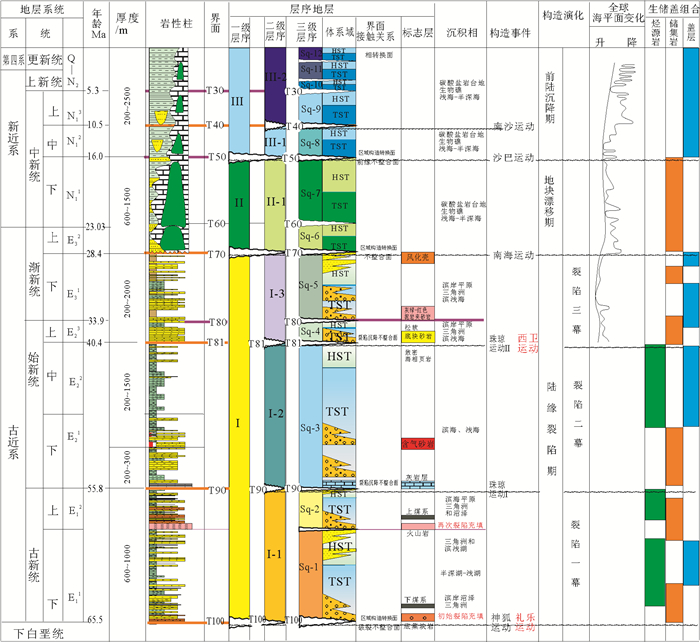
 下载:
下载:
